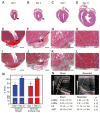Transient regenerative potential of the neonatal mouse heart
- PMID: 21350179
- PMCID: PMC3099478
- DOI: 10.1126/science.1200708
Transient regenerative potential of the neonatal mouse heart
Abstract
Certain fish and amphibians retain a robust capacity for cardiac regeneration throughout life, but the same is not true of the adult mammalian heart. Whether the capacity for cardiac regeneration is absent in mammals or whether it exists and is switched off early after birth has been unclear. We found that the hearts of 1-day-old neonatal mice can regenerate after partial surgical resection, but this capacity is lost by 7 days of age. This regenerative response in 1-day-old mice was characterized by cardiomyocyte proliferation with minimal hypertrophy or fibrosis, thereby distinguishing it from repair processes. Genetic fate mapping indicated that the majority of cardiomyocytes within the regenerated tissue originated from preexisting cardiomyocytes. Echocardiography performed 2 months after surgery revealed that the regenerated ventricular apex had normal systolic function. Thus, for a brief period after birth, the mammalian heart appears to have the capacity to regenerate.
Figures




References
Publication types
MeSH terms
Grants and funding
LinkOut - more resources
Full Text Sources
Other Literature Sources
Miscellaneous

